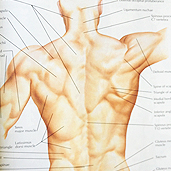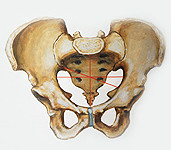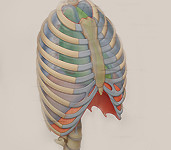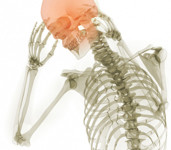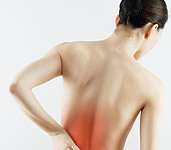Neck & Back pain
Neck and back pain is a common complaint and reason for seeking help from a physiotherapist or chiropractor. Our habit of sitting or standing for long periods is a common contributing factor, along with poor posture, inadequate core muscle strength and repeated bending and rotation forces.
Common causes of neck pain
1) Improper posture of the head, neck, thorax and shoulder complex
Forward head posture results in greater demand on the neck muscles to support the head and uneven forces on the vertebral joints of the neck.
A low hanging shoulder and shoulder blade (scapula) can also cause neck pain and headaches by the pull of muscles that connect the head and neck to the scapula.
2) Stress and tension – the upper trapezius muscle tends to hold tension from psychological stress. It is a natural reaction during times of prolonged stress to maintain the shoulders in a raised position, keeping this muscle in constant contraction, leading to reduced blood flow, cramping and spasm.
3) Whiplash injury – the high forces of impact on the mobile, free moving neck can cause muscle strain, ligamentous sprain and motion restrictions of the vertebral joints. Neck dysfunctions can lead to headaches and radiating pain into the arm and hand.
4) In many cases, the neck is the driver of the problem. However, neck dysfunctions can be a consequence or compensation for a primary dysfunction elsewhere in the body. If focus of treatment is solely on the neck, the problem will recur. To address the problem at its root, the primary dysfunction must be corrected.
Case Study – Upper Trapezius Spasm
55-year-old male patient complained of recurrent spasm and pain in his left upper trapezius muscle, which recurred at least 3 to 4 times a year. It would last a week or two and then subside with little niggles in between. This episode, the discomfort was so great that he could not find a comfortable position for his neck and right arm. His history revealed that as a teenager, he had a job for four years delivering newspapers, going from door to door with a heavy sack on his right shoulder as he threw the newspaper with his left hand. The heavy sack over time caused an overuse and weakening of his right upper trapezius, such that it was not able to support his right shoulder blade and arm in an elevated position. The right upper trapezius had been stretched and was under strain. Countless massage sessions failed to correct the problem, since releasing an already elongated muscle either does nothing or makes it worse. Treatment involved two sessions of educating him on keeping the right upper trapezius shortened and supported as much as possible, with shoulder shrug exercises aimed at shortening and strengthening it. He was pain-free in two sessions and has not had a recurrence.
Causes of Low Back Pain
Low back pain or pain in the lumbar spine presents a challenge to healthcare practitioners because in many cases, the root cause of the problem lies outside this area and the lumbar spine is merely the victim of the dysfunction elsewhere. It is sandwiched between its closest neighbours – the thorax and pelvis, and farther out, the hip, knee and foot below and the neck, shoulder, scapula and head above. Dysfunction in any of these areas above and below, acting solo or in combination, will lead to compensatory rotations in the body. The discs and joints in the lumbar spine are sensitive to torque and rotational forces that can eventually lead to break down, degenerative changes and disc herniations.
Contributing factors include prolonged sitting, poor ergonomics and body mechanics, tight hamstrings and muscles of the pelvis.
Case Study – Back Pain caused by dural tension from a previous head injury:
45-year-old male patient complained of left-sided low back pain, worse especially with bending forward. It was so intense that it hurt every time he rolled over in bed, or made the slightest move. This pain would come on and off in the last 5 years. His history revealed the odd ankle sprain, fractured finger bone and sprained knee ligament. Then he recalled how he had fallen out of a moving vehicle as a teenager and fractured his skull.
I kept this in the back of my mind. When bending forward, he complained of sharp pain on the left lower back near 12th rib and a muscle called the quadratus lumborum. When I tested this area, there was no local tenderness or mal-alignment. That led me to look elsewhere. Remembering the head trauma incident, I aligned the skull bones and then gave his head a little tug to stretch the dura (outer sheath of the brain and spinal cord) while he bent forward. This gave him the best pain relief to my surprise. I went to work stretching the dura and membranes of the brain with him lying down. I also created space between the cranial (skull) bones in order to align them using some of craniosacral therapy. After three sessions, he reports being mostly painfree. Home exercise involved him stretching the dura and membrances on his own.

